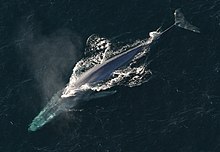
Back Blouwalvis Afrikaans Blauwal ALS Balaenoptera musculus AN حوت أزرق Arabic حوت ازرق ARZ Balaenoptera musculus AST Megenol (Balaenoptera musculus) AVK निलहा व्हेल AWA Göy balina Azerbaijani Блакітны кіт Byelorussian
| Blue whale Temporal range:
| |
|---|---|

| |
Adult blue whale
(Balaenoptera musculus) | |
Size compared to an average human
| |
| Scientific classification | |
| Domain: | Eukaryota |
| Kingdom: | Animalia |
| Phylum: | Chordata |
| Class: | Mammalia |
| Order: | Artiodactyla |
| Infraorder: | Cetacea |
| Family: | Balaenopteridae |
| Genus: | Balaenoptera |
| Species: | B. musculus
|
| Binomial name | |
| Balaenoptera musculus | |
| Subspecies | |
| |

| |
| Blue whale range (in blue) | |
| Synonyms | |
| |
The blue whale (Balaenoptera musculus) is a marine mammal of the suborder of baleen whales (called Mysticeti). They grow to be about 30 m (98 ft) long. The biggest blue whale found was 190 t (210 tons) and measured 98 ft (30 m) long.[3][4] Larger specimens have been measured at 110 ft (34 m), but never been weighed. This makes blue whales the largest animals to ever live on Earth, even bigger than the largest dinosaurs.
The blue whale eats mostly very tiny creatures, like krill, which had decreased in population by 19%-29% due to the consumption of whales.These inch-long, shrimp-like crustacean swim in large swarms. In the Antarctic summer, there are so many of these krill that they turn the waters orange. A blue whale can eat 8 to 10 t (7.9 to 9.8 long tons; 8.8 to 11.0 short tons) of krill every day,[5] Which had caused a rapid weight gain in whales, especially in the humpback whales.[6]
The blue whale's body is long and slender. It can be various shades of bluish-grey above and somewhat lighter underneath.[7] There are at least three different subspecies: B. m. musculus of the North Atlantic and North Pacific, B. m. intermedia of the Southern Ocean and B. m. brevicauda (also known as the pygmy blue whale) found in the Indian Ocean and South Pacific Ocean. B. m. indica, found in the Indian Ocean, may be another subspecies. As with other baleen whales, its diet consists almost exclusively of small krill.[8]
Blue whales were once numerous around the world. In the nineteenth century, they were hunted almost to extinction by whalers. They were finally protected by the International Community in 1966. A 2002 report estimated there were 5,000 to 12,000 blue whales worldwide,[9] located in at least five groups. More recent research into the Pygmy subspecies suggests this may be an underestimate.[10] Before whaling, the largest population was in the Antarctic, numbering approximately 239,000 (range 202,000 to 311,000).[11] There remain only much smaller (around 2,000) concentrations in each of the eastern North Pacific, Antarctic, and Indian Ocean groups. There are two more groups in the North Atlantic, and at least two in the Southern Hemisphere. The North Atlantic group of Blue Whales can be seen in the Saguenay-St. Lawrence Marine Park near Tadoussac QC, Canada.[12]
- ↑ Reilly, S. B.; Bannister, J. L.; Best, P. B.; Brown, M.; Brownell Jr., R. L.; Butterworth, D. S.; Clapham, P. J.; Cooke, J.; Donovan, G. P.; Urbán, J. & Zerbini, A. N. (2008). "Balaenoptera musculus". The IUCN Red List of Threatened Species. 2008: e.T2477A9447146. doi:10.2305/IUCN.UK.2008.RLTS.T2477A9447146.en.
- ↑ "Species Profile". ecos.fws.gov. Archived from the original on 21 July 2021. Retrieved 6 February 2020.
- ↑ Calambokidis, J.; Steiger, G. (1998). Blue whales. Voyageur Press. ISBN 0-89658-338-4.
- ↑ "Animal Records". Smithsonian National Zoological Park. Archived from the original on 1 August 2016. Retrieved 29 May 2007.
{{cite web}}: More than one of|archivedate=and|archive-date=specified (help); More than one of|archiveurl=and|archive-url=specified (help) - ↑ Piper, Ross 2007. Extraordinary Animals: An encyclopedia of curious and unusual animals. Greenwood Press.
- ↑ Baines, Mick; Jackson, Jennifer A.; Fielding, Sophie; Warwick-Evans, Vicky; Reichelt, Maren; Lacey, Claire; Pinder, Simon; Trathan, Philip N. (2022-11). "Ecological interactions between Antarctic krill (Euphausia superba) and baleen whales in the South Sandwich Islands region – Exploring predator-prey biomass ratios". Deep Sea Research Part I: Oceanographic Research Papers. 189: 103867. doi:10.1016/j.dsr.2022.103867. ISSN 0967-0637.
{{cite journal}}: Check date values in:|date=(help) - ↑ "Species Fact Sheets: Balanoptera musculus (Linnaeus, 1758)". Fisheries and Aquaculture Department, Food and Agriculture Organization, United Nations. Retrieved 2012-12-24.
- ↑ Jason de Koning and Geoff Wild (1997). "Contaminant analysis of organochlorines in blubber biopsies from blue whales in the St. Lawrence Seaway". Trent University. Archived from the original on 2017-03-28. Retrieved 2007-06-29.
{{cite web}}: More than one of|archivedate=and|archive-date=specified (help); More than one of|archiveurl=and|archive-url=specified (help) - ↑ "Assessment and Update Status Report on the Blue Whale Balaenoptera musculus" (PDF). Committee on the Status of Endangered Wildlife in Canada. 2002. Retrieved 2007-04-19.
- ↑ Alex Kirby (19 June 2003). "Science seeks clues to pygmy whale". BBC News Online. Retrieved 21 April 2006.
- ↑ T.A. Branch, K. Matsuoka and T. Miyashita (2004). "Evidence for increases in Antarctic blue whales based on Bayesian modelling". Marine Mammal Science. 20 (4): 726–754. doi:10.1111/j.1748-7692.2004.tb01190.x.
- ↑ "Species – Parc marin du Saguenay-Saint-Laurent". Archived from the original on 2021-01-17. Retrieved 2021-03-19.
{{cite web}}: More than one of|archivedate=and|archive-date=specified (help); More than one of|archiveurl=and|archive-url=specified (help)

